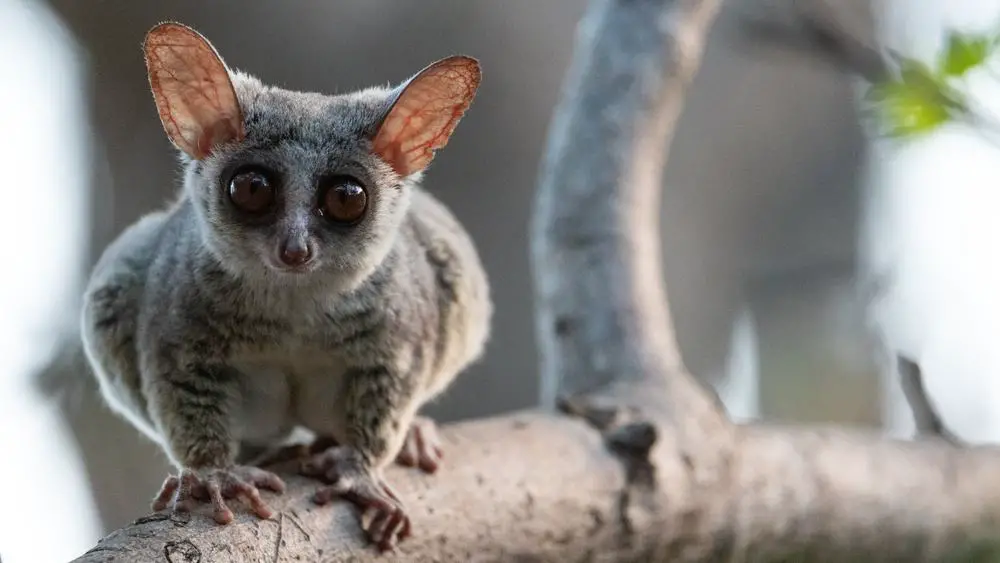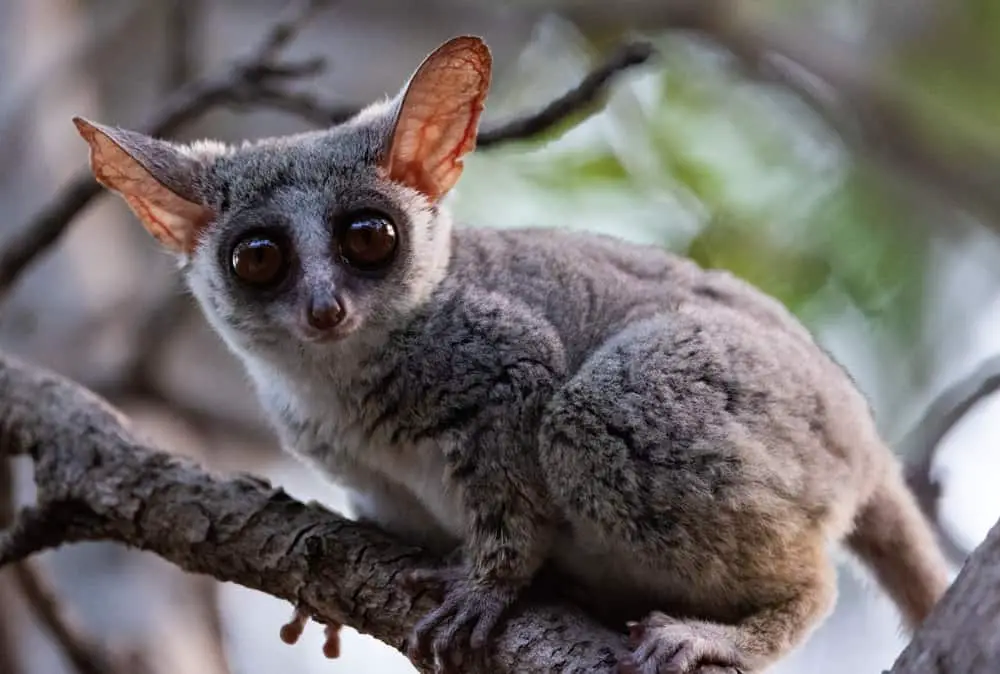Galagidae, also known as bushbabies, are a group of primates that belong to the family Galagidae. These small nocturnal creatures inhabit sub-Saharan Africa and have unique physical features including large eyes, elongated limbs, and a long tail used for balance.
While they may appear cute and cuddly, galagidae are highly specialized animals with distinct behavioral patterns.
Despite their widespread distribution across Africa, little is known about the exact number of species in this family due to difficulties in identifying them based on morphology alone. Recent molecular studies suggest there could be up to 20 different species within the Galagidae family but much more research is needed before any conclusive evidence can be drawn.
Nonetheless, these elusive primates remain one of the most fascinating groups of animals on Earth, intriguing scientists and nature enthusiasts alike.

Genera
- Genus Euoticus – needle-clawed bushbabies
- Genus Galago – lesser bushbabies
- Genus Galagoides – western dwarf galagos
- Genus Otolemur – greater galago
- Genus Paragalago – eastern dwarf galagos
- Genus Scuirocheirus – squirrel galagos
Physical Characteristics Of Galagidae
Physical characteristics of galagidae
Galagidae, also known as bushbabies, are small primates found in Africa. They typically have large eyes, a small nose, and large ears. Their bodies are covered in thick fur, which can be gray, brown, or reddish-brown in color.
Bushbabies have long tails that are used for balance and communication. They are also able to leap long distances thanks to their powerful hind legs. In terms of size, bushbabies range from about 4 to 16 inches in length and weigh anywhere from 2 to 24 ounces.
Overall, the physical characteristics of galagidae make them well-adapted to their arboreal lifestyle in the forests and woodlands of Africa.
Behavioral Patterns Of Bushbabies
Galagidae, commonly known as bushbabies, are unique primates found in sub-Saharan Africa. They possess many interesting physical characteristics that make them stand out from other primates. However, their behavioral patterns and nocturnal habits also deserve attention.
Did you know that bushbabies can jump up to six feet in one leap? This incredible statistic inspires awe for these small creatures’ agility and athleticism. But beyond this impressive feat, there is much more to learn about Galagidae’s behavior. Here are some of the most noteworthy points:
- Bushbabies use a variety of vocalizations, including calls, whistles, screams and grunts.
- They mark their territories with urine and secretions from scent glands on their wrists and chests.
- These primates have an unusual social structure where males play a larger role in caring for offspring than females.
- Galagidae are primarily arboreal animals but will come down to the ground to search for food or escape predators.
The communication methods and nocturnal habits of Galagidae are critical aspects of understanding their behavior. Their wide range of vocalizations allows them to communicate with each other over long distances effectively. The marking of territories indicates how important it is for bushbabies to maintain boundaries between themselves and others. Being primarily active at night makes them less visible to predators while allowing them access to food sources not available during the day.
Overall, these fascinating traits demonstrate just how complex and intriguing galagos can be without even considering their physical features!
Habitat And Distribution
Galagidae, also known as galagos or bushbabies, are a family of small nocturnal primates that inhabit the forests and woodlands of sub-Saharan Africa. They have been found in various types of habitats such as rainforests, savannas, montane forests, and dry woodland areas. However, these species mostly prefer dense vegetation with high canopy density where they can easily move around using their specialized leaping abilities.
The distribution range of galagos varies depending on the species. Some species like the Senegal Galago (Galago senegalensis) are widely distributed throughout West Africa while others like Mohol Bushbaby (Galago moholi) are restricted to specific regions in southern Africa.
Due to habitat loss caused by human activities like deforestation and agriculture expansion, some populations of galagos have experienced declines in numbers. Several conservation efforts have been put in place to address this issue including the creation of protected areas for these animals and promoting sustainable land use practices that minimize negative impacts on their natural habitats.
Evolutionary history plays a significant role in understanding the current distribution pattern of galagos. Phylogenetic studies have shown that galagos diverged from other primates about 63 million years ago during the Paleocene epoch when there was an extensive forest cover across most parts of Africa.
As climatic conditions changed over time leading to increased aridification and grassland expansion, many primate lineages went extinct or adapted to new environments resulting in modern-day diversity patterns observed in African Primates today including Galagidae. Further research into evolutionary relationships among different species will provide more insights into how these adaptive strategies shaped their diversity patterns under changing environmental conditions over millions of years without interference from humans which is key to developing effective conservation management plans for them going forward.
Identifying Galagidae Species
Galagidae, commonly known as bushbabies or galagos, is a family of small nocturnal primates native to Africa. There are currently 19 recognized species within this family, each with unique physical characteristics and ecological niches.
Identifying different Galagidae species can be challenging due to their elusive nature and similar appearances. However, several key features such as fur color patterns, tail length, and skull morphology can aid in distinguishing between species.
Understanding the ecology of Galagidae species is crucial for conservation efforts. These primates play an important role in their ecosystems as seed dispersers and insectivores. Many Galagidae populations are threatened by habitat loss from deforestation, agriculture expansion, and human encroachment.
Conservation measures such as protected areas and habitat restoration projects have been established to mitigate these threats. Additionally, raising awareness about the value of preserving biodiversity can help ensure the survival of Galagidae species for future generations.
Molecular Studies And Species Diversity
Genetic variability is an essential aspect of understanding the evolutionary relationships among galagidae species. Molecular studies provide a reliable tool for evaluating genetic diversity, which assists in defining taxonomic boundaries and determining the ancestry of different species.
The mitochondrial DNA (mtDNA) has been widely used to study the genetic background of primates due to its high substitution rate, maternal inheritance, and small genome size. Additionally, nuclear DNA markers such as microsatellites have also provided valuable information about population structure, gene flow and hybridization between closely related species.
Molecular studies on Galago senegalensis revealed significant genetic differentiation within this species from different geographic regions characterized by distinct morphological features. In contrast, G. moholi showed higher levels of homogeneity across its range despite showing considerable variation in coat coloration patterns.
Moreover, molecular data indicate that some populations previously classified under one species are genetically isolated enough to warrant recognition as independent taxa at the subspecies or even species level. These findings emphasize the importance of incorporating molecular data into traditional taxonomy when delineating primate diversity and highlight the need for further research efforts aimed at refining our understanding of galagidae evolution through time.

Fascinating Facts About Galagidae
- Bushbabies have a specialized joint in their ankle that helps them leap up to 10 feet in just one jump!
- They communicate with each other through various vocalizations such as whistles and screams.
- The large eyes of bushbabies enable them to see clearly at night, which is when they are most active.
Despite being adorable, these little creatures face numerous threats from habitat loss and hunting. Wildlife conservation efforts aim to protect their habitats while educating local communities about the importance of preserving biodiversity. By conserving galagidae populations, we can learn more about their role in ecosystem function and help ensure their survival for future generations.
Conclusion
Galagidae, commonly known as bushbabies or galagos, are a family of small primates that are native to Africa. These nocturnal creatures have large eyes and ears which enable them to navigate in the dark and locate their prey. They also possess long tails that help them balance while jumping from tree to tree.
Galagidae is highly social animals that live in groups consisting of one male, several females, and their offspring. They communicate with each other through vocalizations such as screams, barks, and whistles. Bushbabies are primarily insectivorous but may also feed on fruits, gums, and nectar.
The habitat range for Galagidae includes sub-Saharan Africa where they inhabit rainforests, savannas, scrublands, and woodlands. The identification of various species within this family can be challenging due to similarities in physical characteristics. However molecular studies have aided experts in determining distinct species based on genetic differences.
A fascinating fact about Galagidae is that they engage in urine washing behavior as a means of communication and marking territory boundaries. For example, if two different families encounter each other’s territories during night-time feeding activities the dominant male will mark his presence by urinating on trees surrounding his territory limits.
In conclusion, Galagidae is an intriguing primate family whose unique physiological adaptations allow them to thrive in African ecosystems under cover of darkness.

